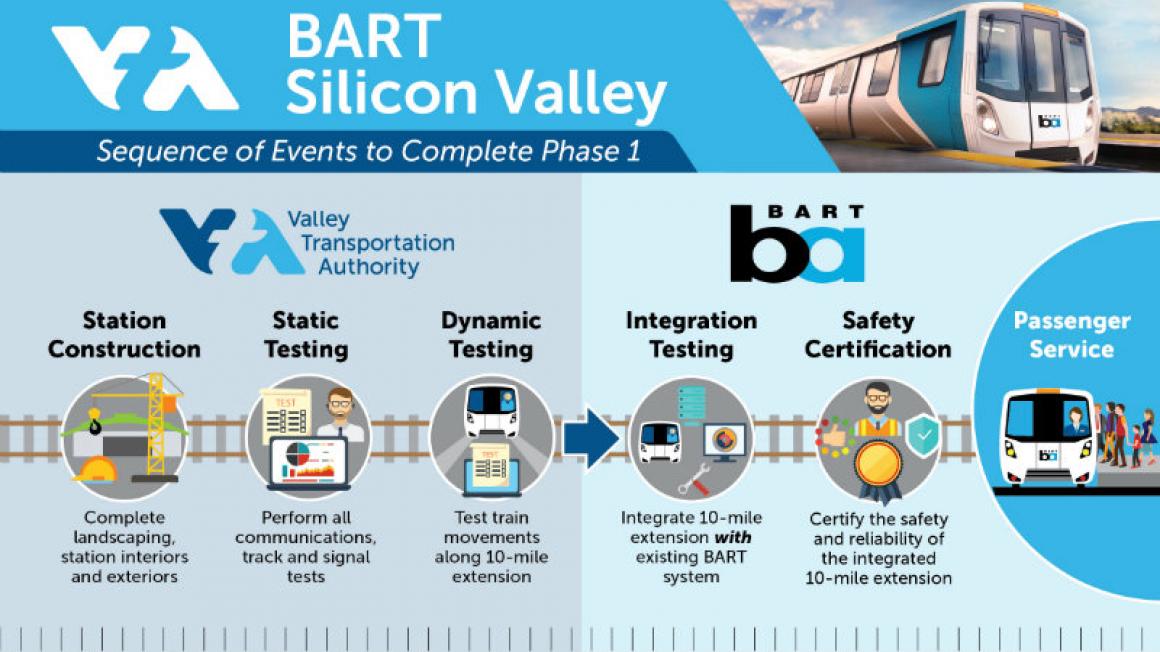Although construction of VTA’s BART Berryessa Extension Project’s stations, track and systems is essentially complete, several months of critical work is required before the public can start riding BART in Santa Clara County. Currently, Santa Clara County residents and commuters are already benefiting from roadway improvements, flood control and environmental mitigations included in the project, and economic and land development due to the project.
In early 2019 VTA and BART will be in a better position to project a service date.
The project was designed and built to meet the rigorous requirements of state and federal regulatory agencies and the unique requirements of the operator - BART. The physical structures, power source, and communications are fully operational; however, preparing for safe, reliable and fully-integrated passenger service requires extensive testing, functional verification, troubleshooting, reconfiguring, reprogramming and retesting.
Two main BART operations systems require this rigorous testing: train control and Supervisory Control and Data Acquisition (SCADA) – a communications and operating system which monitors and/or controls every aspect of the rail system and facilities. Only when all the physical assets are in place; the track circuitry, train electronics and communications are networked; and the system is live in its own unique configuration, can real situational and operational scenarios be tested. This is because each extension of the regional system has unique geography, structures and facilities, differing from anything previously built or operated.
BART trains are powered by direct current (DC) electricity that runs through an energized third rail along-side the tracks and are routinely operated in an “automatic” mode. While an operator in the cab can manually control and monitor all train movements and conditions, and provide a failsafe back-up, the train movements are primarily controlled by a combination of track circuits and train electronics. When operating in “automatic” mode, trains run without operator input and are controlled and monitored from a remote Operations Control Center.
The combination of track circuits and train electronics means that all points of contact between the train wheels and the track completes a control circuit – and it all has to be tested. Each inch of track must be tested for every possible condition and situation to ensure the trains respond appropriately. If something is not operating or responding as designed during testing, corrections are made. The resulting fix is then tested again. This aspect of testing, overseen by VTA, began last fall and it is anticipated that this work will be completed by the end of this month. BART will then begin conducting their train control testing to integrate the new extension into the existing system.
The train control system interfaces with the SCADA system. SCADA controls, monitors and communicates every other aspect of BART system operations. There are over 3000 pieces of equipment controlled and monitored via this system including elevators, telephones, radios, lights, thermostats, fire and security alarms, emergency ventilation fans, speakers, sprinklers, closed-circuit television, and the public announcement system. This results in a tremendous amount of data and interfaces that need to be tailored to specific operational practices and preferences.
While all design specifications were met, similar to train control, ideal operability and functionality can’t be tested or evaluated until every component that feeds into the SCADA system is complete. In contrast to train control testing, the human interface and interpretation are essential elements of this testing phase. The SCADA system and its sub systems provide the essential tools that BART personnel use to manage day-to-day operations from the Operations Control Center.
VTA is working closely with BART personnel to ideally configure the system for maximum operational benefits. VTA will work with BART over the next couple months on this “customization” and then BART will conduct additional testing and overall system integration.
Concurrently with these efforts, engineers, maintenance and operations staff, and station agents are being trained on the unique aspects of the new extension. In total, several months of programming, testing and integration are required before the system is certified for passenger service.
Once the project reaches the final stages of testing and integration, a more precise date for passenger service will be announced. VTA and BART are dedicating all available resources to advancing testing in an expedient manner to deliver a safe and fully-operational system as soon as possible.
VTA’s BART Berryessa Extension - What’s Needed to Begin Passenger Service?
06/07/2018
